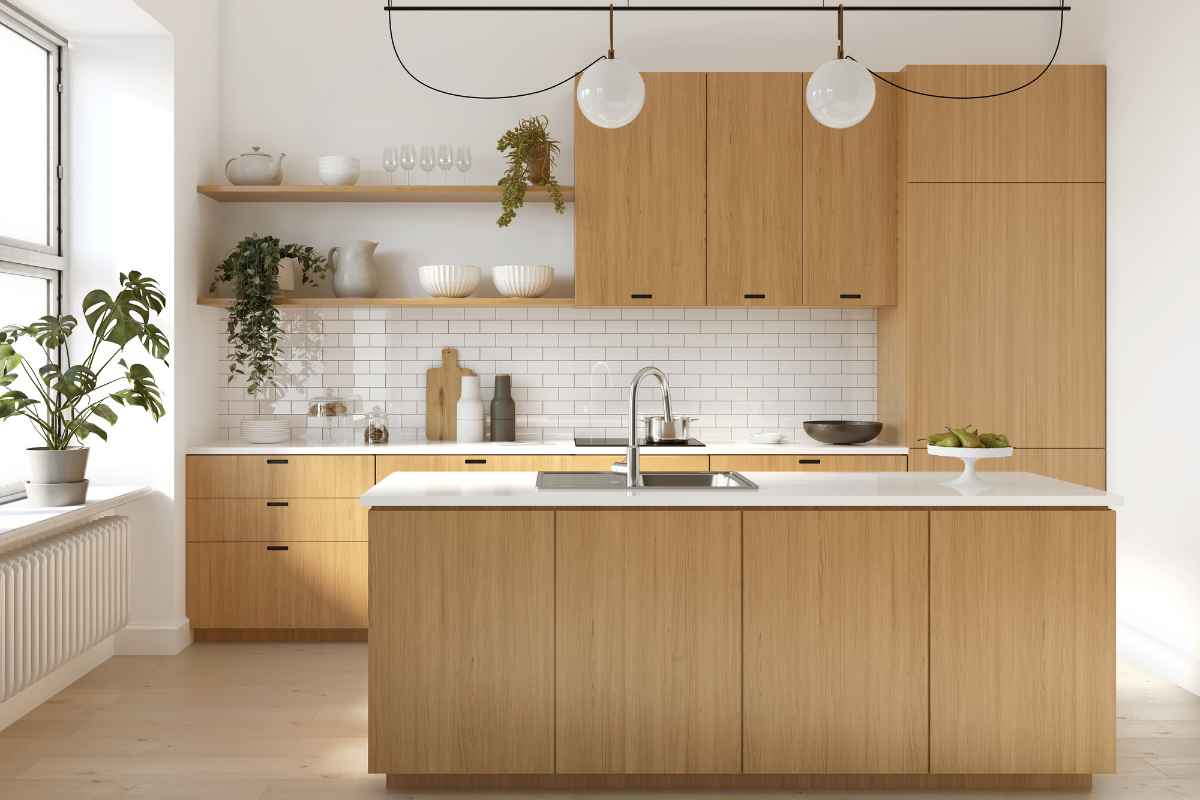A Complete Guide To Maintaining Optimal Air Quality In Your Kitchen
Cooking joy is marred by lingering smoke, grease, and odors. Improve your kitchen's air with our guide to keeping it fresh, healthier, more pleasant cooking.

Cooking can be a joy, but smoke, grease, and odors can linger in the air, making your kitchen feel stuffy and unpleasant. This isn't just a comfort issue—poor air quality can irritate your lungs and make spending time in the kitchen less enjoyable. The good news is that there are simple steps you can take to keep your kitchen air fresh and healthy. This guide will walk you through everything you need to know to maintain optimal air quality in your kitchen, so you can focus on creating delicious meals, not clearing the air.
What Affects Your Kitchen Air
Just like you consider fresh ingredients for delicious meals, clean air is an essential part of a healthy and enjoyable kitchen environment. Kitchen air quality refers to the cleanliness and composition of the air you breathe while cooking. Unlike outdoor air quality, which can be impacted by a variety of factors, kitchen air pollution is primarily caused by the activities that happen within your cooking space.
Here are some of the common culprits that can negatively affect your kitchen air:
- Cooking Emissions: Frying, grilling, and searing food can release smoke, grease particles, and volatile organic compounds (VOCs) into the air. These emissions can irritate your lungs and eyes, and some VOCs can even be harmful to your health in high concentrations.
- Gas Stoves: Gas stoves can contribute to indoor air pollution by releasing carbon monoxide and nitrogen dioxide. These gases can cause headaches, dizziness, and respiratory problems.
- Cleaning Products: Many cleaning products contain harsh chemicals that can irritate your respiratory system and leave behind lingering odors.

Understanding these common sources of pollution helps you take steps to improve your kitchen air quality and create a healthier cooking environment.
The Role of Ventilation
Imagine trying to cook a delicious stir-fry with the smoke alarm blaring—that's what a poorly ventilated kitchen can feel like. Proper ventilation is the key to removing unwanted pollutants and maintaining optimal air quality in your kitchen. Here's how it should work:
- Exhausting Unwanted Elements: A good ventilation system acts like a tiny vacuum cleaner for your kitchen. It captures smoke, grease, steam, and odors produced while cooking and removes them from your breathing space. This helps prevent these pollutants from lingering in the air and irritating your lungs or settling on surfaces.
- Controlling Temperature and Humidity: Cooking can generate a lot of heat and moisture. Proper ventilation helps remove this excess heat and humidity, keeping your kitchen cooler and more comfortable. This is especially important during the summer months or when using high-heat cooking methods.
There are two main types of ventilation systems commonly found in kitchens:
- Range Hoods: These are mounted directly above your stovetop and capture pollutants as they rise from cooking. Look for hoods with a strong exhaust fan and metal mesh filters that can be easily cleaned.
- Downdraft Ventilation Systems: These innovative systems are built directly into your cooktop and suck pollutants downwards before they can rise into the air. This can be a space-saving option and is particularly effective for capturing low-lying smoke and odors.
While a good ventilation system is essential, a ceiling fan in a kitchen can also play a supporting role in improving your kitchen air quality. By circulating the air throughout the room, ceiling fans can help:
- Disperse Lingering Odors: Even after using your ventilation system, faint cooking smells might linger. A ceiling fan can help distribute these odors throughout the room, making them less noticeable.
- Enhance the Effectiveness of Ventilation: Employing expert ceiling fan installers for optimal placement can amplify the effectiveness of air flow redirection toward the range hood, enhancing its ability to capture pollutants directly at their source.
In essence, ventilation isn't just about keeping your kitchen smelling fresh—it's about creating a healthy and comfortable cooking environment.
Air Purifying Plants
While ventilation is the primary weapon against kitchen air pollutants, there's another natural defense you can add to your arsenal—houseplants. Certain plants have the remarkable ability to absorb airborne toxins and improve indoor air quality. Here are some top choices for your kitchen:
- Snake Plant (Sansevieria): This low-maintenance champion thrives in bright, indirect sunlight and is a superstar at filtering out common indoor air pollutants like formaldehyde and benzene, often found in cleaning products and building materials.
- Peace Lily (Spathiphyllum): This elegant beauty prefers medium to low light and boasts the ability to remove pollutants like ammonia and benzene from the air. Plus, it will even alert you to watering needs with its distinctive drooping leaves.
- Spider Plant (Chlorophytum comosum): The National Aeronautic and Space Administration (NASA) conducted studies to evaluate the effectiveness of certain indoor plants in eliminating formaldehyde from the air. Initial findings indicated that spider plants excelled, successfully purifying 95 percent of the harmful substance.
When selecting a spot for your leafy air purifiers, consider these tips:
- Proximity to the Cooking Zone: While you don't want your plants directly in the line of fire, placing them near your stove or oven can still allow them to capture some airborne pollutants.
- Light Conditions: Match the plant's light requirements with your kitchen's natural light availability. Some plants, like snake plants, can tolerate lower light conditions, while others, like pothos (another excellent air-purifying option), may need brighter indirect light.
- Watering Needs: Research your chosen plants' watering requirements. Overwatering can be detrimental, so err on the side of dryness and water only when the top inch of soil feels dry to the touch.
Plants won't replace a good ventilation system, but they can be a delightful and effective addition to your kitchen's air quality strategy.
Keeping it Clean
A sparkling clean kitchen isn't just about aesthetics—it's also essential for maintaining good air quality. Food particles, grease build-up, and even crumbs can harbor bacteria and contribute to lingering odors. Here's how to incorporate smart cleaning practices into your daily and weekly routines to keep your kitchen fresh and your air clean:
Daily Do-Overs:
- Wipe Down Spills Immediately: Don't let spills sit and dry. A quick wipe-up with a damp cloth or disinfectant spray prevents food particles from becoming airborne and creating odors.
- Clean Stovetops After Every Use: Grease splatters and food residue on your stovetop can release pollutants when heated. Wipe them down with a stovetop cleaner after cooking to prevent build-up.
- Empty Crumbs from Your Toaster and Oven Daily: Crumbs can burn and emit unpleasant odors, so get into the habit of emptying your toaster and oven trays every day.
Weekly Deep Clean:
- Scrub Floors and Wipe Down Cabinets: Food particles and grease can accumulate on floors and cabinets. Weekly cleaning with a mop and disinfectant wipes removes these potential sources of airborne contaminants.
- Disinfect Countertops: Countertops are prime prep zones, so give them a thorough cleaning with a disinfectant solution at least once a week. This eliminates bacteria and prevents lingering food odors.
- Clean and Replace Oven Filters: Many ovens have grease filters that trap airborne particles. Regularly clean these filters according to the manufacturer's instructions and replace them when necessary.
- Don't Forget the Microwave: Food splatters and spills inside your microwave can harbor bacteria and create unpleasant smells. Wipe down the interior with a damp cloth or a mild cleaning solution weekly.
Keeping your kitchen clean isn't just about sparkling surfaces—it's about creating a breath of fresh air in your cooking haven. The result? A cleaner, fresher kitchen that makes every culinary creation a joy.
Investing in Air Purifiers
While ventilation and consistent cleaning are the cornerstones of good kitchen air quality, an air purifier can be a valuable addition to your arsenal. These handy devices work by actively filtering the air and removing pollutants that might linger even after using your range hood and cleaning routine. If you're considering an air purifier for your kitchen, here's what you need to know:
- HEPA Filtration: Look for an air purifier with a High-Efficiency Particulate Air (HEPA) filter. This type of filter is highly effective at capturing microscopic particles like smoke, dust, and allergens, which can all contribute to reduced air quality in your kitchen.
- Activated Carbon Filtration: In addition to a HEPA filter, consider an air purifier with activated carbon filtration. This type of filter is excellent at absorbing odors and volatile organic compounds (VOCs) commonly released during cooking.
- Air Coverage: Choose an air purifier with a Clean Air Delivery Rate (CADR) rating suitable for the size of your kitchen. The CADR rating indicates the volume of air the purifier can clean per minute.
Investing in an air purifier equipped with suitable features for your kitchen adds an additional layer of protection against persistent smells, smoke particles, and airborne pollutants. This can be particularly beneficial for those with allergies or sensitivities or for kitchens with limited ventilation options.
Breathe Easy and Cook Happy
Ensuring the best air quality in your kitchen goes beyond controlling unwanted smells; it involves making the cooking space healthier and more pleasant. From investing in a powerful ventilation system to incorporating smart cleaning habits into your routine, you now have a comprehensive toolbox to tackle kitchen air quality.
Remember, a little planning and consistent effort can make a big difference. So, put on your apron, turn on the vent, and get ready to cook delicious meals in a clean and refreshing kitchen.




Comments ()